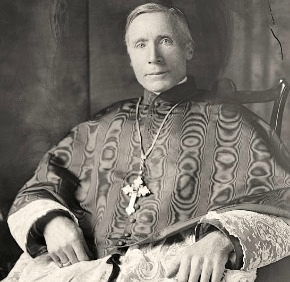By George P. Matysek Jr.
gmatysek@CatholicReview.org
Twitter: @ReviewMatysek
When Bishops Adam J. Parker and Mark E. Brennan were ordained auxiliary bishops for the Archdiocese of Baltimore Jan. 19, it wasn’t the first time the archdiocese celebrated two priests elevated to the rank of bishop on the same day. Twice before, the Cathedral of Mary Our Queen in Homeland played host to more than one episcopal ordination.
Archbishop William D. Borders ordained then-Monsignors P. Francis Murphy and J. Francis Stafford as bishops Feb. 29, 1976. Eight years later, the archbishop ordained then-Monsignor William C. Newman and Josephite Father John H. Ricard to the same office July 2, 1984.
The 1976 ordination rite featured several innovations, including the use of lay people and women religious joining the archbishop in the ritual questioning of the bishops-designate.

Archbishop William D. Borders ordains Bishop P. Francis Murphy as an auxiliary bishop for the Archdiocese of Baltimore in 1976. (CR File)
During the offertory procession at Mass, many gifts were brought forward, including a bowl of rice, symbolic of world poverty and hunger; a broken chain, symbol of the Gospel call to liberation from all oppression; and four books on the role of women in the church, according to a report in the March 5, 1976, issue of the Catholic Review.
Bishop Murphy, a Cumberland native and former longtime priest-secretary to Cardinal Lawrence Shehan, was presented a crosier, carved from a branch of a cedar tree from Mount de Sales Academy in Catonsville. Bishop Stafford, a Baltimore native and alumnus of Loyola Blakefield in Towson who had served as director of Catholic Charities of Baltimore, received a crosier that is believed to have been used by Baltimore Cardinal James Gibbons in the 19th century.
In remarks following the ordination, Bishop Stafford said he hoped to make “the suffering and tears of others my own.” Bishop Murphy said his dream as a bishop was “to bring people to truly love one another.”
The 1984 ordination marked a historic moment for the archdiocese when then-Father Ricard became its first African-American bishop. The liturgy featured a blending of traditions as music by Brahms and African-American gospel songs were led by the Cathedral Choir and the combined Urban Gospel Choir, according to an article in the July 6, 1984, issue of the Catholic Review.
Born in Baton Rouge, La., Bishop Ricard had served as associate pastor and then pastor of Josephite parishes around the country.
Bishop Newman, a Baltimore native and graduate of Calvert Hall College High School, was the former principal of St. Paul Latin High School in Baltimore and archdiocesan superintendent of education.
In his homily at the 1984 ordination, Archbishop Borders challenged the new bishops to work toward muting tensions, correcting injustices and dissipating prejudices.
“Influential people will tell you, when you speak on social evils, to confine yourself to the pulpit and stay out of economics, politics and international relations,” he said. “Your response must be that justice does not exist in the abstract, but in the arena where decisions are made relative to the basic rights that affect the lives of all people.”
At the conclusion of Mass, Bishop Newman noted that the litany of the saints reminded him of the men and women who influenced his life. He drew laughter when he thanked his seven sisters “who made me blessed among women.”
Bishop Ricard provoked applause, the Catholic Review reported, when he thanked his mother and deceased father. He noted that if it were not for his mother’s wedding ring, “I would not be wearing my bishop’s ring.”
Read more stories from Our Back Pages here.


